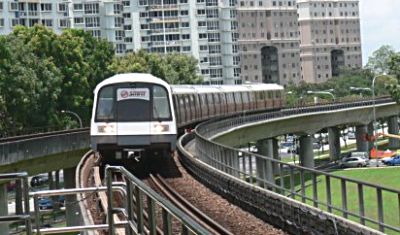Excerpts from analysts' report
Deutsche Bank analysts: Joe Liew, CFA & Joshua Lee, CFA Structural catalysts for SMRT include rail ridership growth and average fare increases from an increasing population.
Structural catalysts for SMRT include rail ridership growth and average fare increases from an increasing population.
NextInsight file photo.SMRT is a natural beneficiary of increased ridership and average fare growth in the rail network as rail income makes up 55% of group revenues.
We expect earnings to improve as ridership numbers grow from government initiatives to promote public transport. Several structural catalysts could support earnings, as listed below:
• The Government Contracting Model (GCM) is forecast to lift bus operating margins to 9% (currently slightly negative) from late-2016.
• Lower oil prices could translate into lower energy expense
• Rail ridership growth and average fare increases from an increasing population, which is shifting further away from the city.
Heavy rail capex is in progress but we see it moderating from FY2017. The sale of bus assets could net S$350m (23cents/share) cash (20% discount to bus NBV in 3Q16). In addition, the 2.8% average gross fare hike from 5 April 2016 is supportive of earnings. SMRT’s North-South-East-West Line (NSEWL) and Circle Line (CCL) reforms could happen in 2018 (there is a higher likelihood that the NSEWL breakdown on 7 July 2015 could speed up the process), and could increase our SMRT target price by 71cents/share. We believe that the reforms could be in the form of peak period surcharge and an asset light model where the government owns operating assets.
On the back of our average fare increase forecast, we have revised our earnings growth for 2015-17 from 21%/11%/16% to 21%/11%/35% (refer to Figure 49). We increase our target price by 20% to S$2.32/share.
|
|
Risks
Key downside risks: loss in rail market share with the introduction of the Downtown Line; higher-than-expected capex; inability to pay dividends; inability to diversify into other businesses due to governmental intervention; higher-than-expected fine because of the 7 July 2015 breakdown; radical change in competitive landscape due to regulatory liberalization; and lower-than-assumed margins for the Singapore bus and rail businesses.
Exposure to foreign currencies is due to diesel and electricity imports in USD. FX and Brent Crude sensitivity is higher than for CD as the bulk of its businessis domestic (compared to c.50% of revenues for CD). Energy expenses are c.15% of costs compared to 10% for CD.




